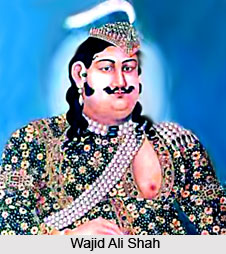 Styles of thumri have developed gradually along the course of the development of the art. Thumri has had a rather long tradition and can be traced right back to the age of classical Sanskrit plays and later to the Vaishnava Bhakti cult and the rasa natya. However, the Thumri as it is known today received great patronage, currency and shape during the days of Wajid Ali Shah when he was the Nawab of Lucknow, from 1847 to 1856. Its present tradition is also linked with Kathak dance and Thumri continues to be an essential feature of the Kathak nirtya. Thumri also evolved as a mode of vocal music without any recourse to the visual, i.e., acting or abhinaya, and aiming its expression only through music and words.
Styles of thumri have developed gradually along the course of the development of the art. Thumri has had a rather long tradition and can be traced right back to the age of classical Sanskrit plays and later to the Vaishnava Bhakti cult and the rasa natya. However, the Thumri as it is known today received great patronage, currency and shape during the days of Wajid Ali Shah when he was the Nawab of Lucknow, from 1847 to 1856. Its present tradition is also linked with Kathak dance and Thumri continues to be an essential feature of the Kathak nirtya. Thumri also evolved as a mode of vocal music without any recourse to the visual, i.e., acting or abhinaya, and aiming its expression only through music and words.
The gharana creed and convention does not have as much of a hold on Thumri as it does on the Khayal. The reason for this is that the nuances of Thumri are not easy to copy and have a subjective character in mood-expression. The Thumri sings of the viraha of Radha or the gopi; it is the main theme, and the effect is sensuous, emotional charged and deep. As for its spiritual significance, it is prema-bhakti, of the prakrti (the transient female element or atma) towards the purusa (the eternal male element; paramatma; god).
Types of Thumri
There are different types of Thumri that are practiced and are in vogue.
Banaras Anga Thumri: It very much suited to the emotive aspects, interpreting the song, the phrases, the words, even projecting several sancari bhavas through vocal techniques, called kaku-prayoga and bola-banava. It requires a non-obtrusive theka in slow tempo in the main phase of the rendering. This style of thumri is similar to the bada khayal, since its bola-banava (mobilizing the words), kahan (utterance), phrasing and rumination is centered round raaga-anga and mixes the main raaga-anga harmoniously and effortlessly, with the song without sudden flights.
Punjab Anga Thumri: It is full of murkis and thrills and creates a special charm when it takes two adjacent notes, like two rsabhas or two gandharas and swift sallies in taans from the higher octave to the lower one. This is definitely a different tradition in notes but it is bound to get repetitive as it gets exhausted after a time. There are musicians today who try to combine these two styles, but it is not a regular feature as each style requires riyaz in a distinctive vocal technique.
Bandisa Thumri: This is the third pattern of thumri where the composition has high musical value. Here, the text is longer having a literary charm, and the composition may be in a raaga and the rendering restricted to it. Kathaks are better reputed to know this type of thumri. This third type is practiced less frequently nowadays. The reason for this appears to be the fact that bhajana, gita, pada and other such fare, called light music, offer nearly everything that a Bandisa Thumri may have to offer musically.
Bola Banao Thumri: It is known as artha-bhava. Artha means meaning and bhava means emotions. The bola-banao thumri is performed at a much slower tempo than the bandisa thumri. In the choreographic context, this form was appropriate for dance formats devoid of fast or intricate footwork. By the early twentieth-century, it stabilized at a rendition tempo approximately twice the beat-density of the contemporary bada khayal.
Thumri as such has now gained a better status in musical hierarchy and in the society during the last thirty years or so compared to what it enjoyed previously. Now nearly every chamber concert or music conference includes thuman in its fare, and nearly every vocalist or instrumentalist wishes to excel in classical as well as light classical both, and endeavors to charm the audience which is keen to listen to a variety of styles. In recent times, there is seen a revival of the jalsas (musical soirees) where thumris are punctuated with dadaras and, ghazals, even gitas and bhajanas. However it must be said here that in the company of other lighter forms, the thumri is in danger of losing its character and form.